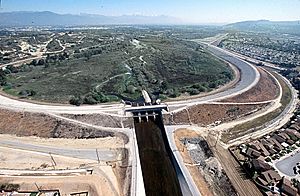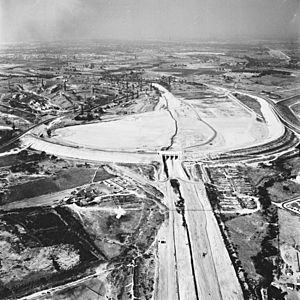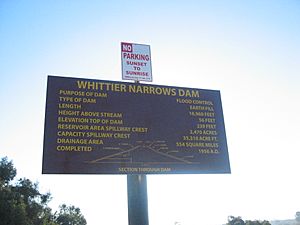Whittier Narrows Dam facts for kids
Quick facts for kids Whittier Narrows Dam |
|
|---|---|

Aerial view of Whittier Narrows Dam looking upstream through the Rio Hondo Spillway.
|
|
| Location | Los Angeles County, California, United States |
| Coordinates | 34°01′12″N 118°04′58″W / 34.02000°N 118.08278°W |
| Opening date | 1956 |
| Dam and spillways | |
| Impounds | Rio Hondo San Gabriel River |
| Height (foundation) | 56 feet (17 m) |
| Length | 16,960 feet (5,170 m) |
| Elevation at crest | 236 feet (72 m) |
| Width (crest) | 32 feet (9.8 m) |
| Dam volume | 12,166 cu yd (9,302 m3) |
| Spillway type | Automated spillway overflow |
| Parapet width | 16 ft (4.9 m) |
| Hydraulic head | 182 ft (55 m) |
The Whittier Narrows Dam is a large earth dam, about 56 feet (17 meters) tall. It sits across two rivers: the San Gabriel River and the smaller, nearby Rio Hondo. This important dam is located in a place called the Whittier Narrows.
Its main jobs are to save water and to control floods. It's a key part of the flood control system for the Los Angeles County area. The area behind the dam can hold a lot of water, about 67,060 acre-feet.
The Whittier Narrows is a natural opening in the hills that border the southern part of the San Gabriel Valley in Southern California. Both the Rio Hondo (which flows into the Los Angeles River) and the San Gabriel River pass through this gap. The dam holds back water from both rivers. Major roads like the Pomona Freeway and the San Gabriel River Freeway also go through or near this area.
In 2017, experts from the United States Army Corps of Engineers said the dam needed upgrades. They explained that it might not be strong enough to handle extremely rare, huge storms. These storms would be similar to the massive floods that hit California in 1861-1862, known as an ARkStorm. The Corps of Engineers is working to make sure the dam can safely handle even the biggest possible floods.
The plan to build the dam was approved in 1941. Money for its construction was provided in 1949. The U.S. Army Corps of Engineers finished building the dam in 1957.
Contents
Controlling Floods: How the Dam Works
The main goal of the Whittier Narrows Dam is to collect rainwater runoff. This water comes from areas upstream that aren't controlled by other dams. It also manages water released from the Santa Fe Dam into the San Gabriel River.
River Outlets and Gates
The dam has different ways for water to flow through it.
- The Rio Hondo side has four main openings, plus a smaller one for diverting water.
- The San Gabriel River side has nine large gates on top of a spillway.
Normally, the gates on the Rio Hondo side are wide open. On the San Gabriel side, one gate is usually open just a little bit (about 0.5 feet or 15 cm), while the others are closed. This means the reservoir behind the dam is usually empty. A special "crossover weir" inside the reservoir keeps the water from the two rivers separate. So, water usually flows through the dam without stopping.
Managing Water During Storms
When a flood starts, the gates on the Rio Hondo side are partly closed. This helps create a pool of water for conservation. As long as the water level on the Rio Hondo side stays below a certain height (about 201.6 feet or 61.4 meters), water is released. This water goes to "spreading grounds" downstream.
The spreading grounds are managed by the Los Angeles County Department of Public Works. They help refill the underground water supply, called the groundwater basin. Water reaches these grounds either directly from the dam or from a special structure in the Rio Hondo further downstream. The county operates both of these water diversion points.
If the water level on the Rio Hondo side gets too high, more water is released to match the incoming flow. This continues until the river downstream (Rio Hondo or Los Angeles River) reaches its full capacity. If the water level on either side of the reservoir gets too high, the San Gabriel side can release about 5,000 cubic feet per second (142 cubic meters per second).
The San Gabriel outlet has gates that open automatically. They open when the water in the reservoir goes above the normal flood control level. This level is about 228.5 feet (69.6 meters).
River Capacities Downstream
Here's how much water the rivers downstream can handle:
- The Rio Hondo, after the dam, can carry about 36,500 cubic feet per second (1,034 cubic meters per second).
- The Los Angeles River, after it joins the Rio Hondo, can carry about 127,000 cubic feet per second (3,596 cubic meters per second).
- The San Gabriel River, after the dam, can carry about 13,000 cubic feet per second (371 cubic meters per second).



